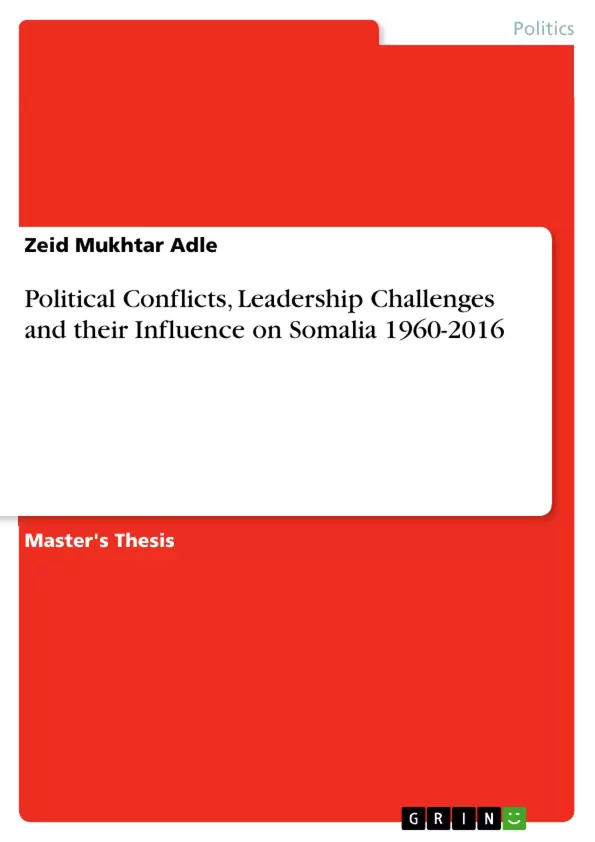This study intends to explore the history of the political conflicts, leadership challenges and their influence on the society of Somalia. For the purpose of data collection, archival data from various websites, scholarly articles and books were gathered. The aim of the study is to try to devise some suitable solutions for the current state of conflict within the country in order to try to minimize it. Therefore, it needs to look into the effects that leadership in Somalia has led to.
This study intends to explore the history of Somalia largely in aspect to the leadership conflicts, political conflicts and its influence on the people and society of Somalia. Not only the effects that have crippled the nation as a community such as the infrastructure and political scenarios risen by the traditional "clanism" and their power play; but also a look into the other aspects of the country that have been neglected and never really looked into - that is a more communal to individual perspective that leans towards everyday factors that have also been affected (such as education); and how more and more attention is given to the government but not enough attention is given to important aspects of a nation such as the development of a better formalized education system and an integration of how leaders should be so that people may know from a young start what is that needs to be done in order to help the country survive and come out of its dark place.
The study aims not only to look at such situations in depth and compare them with one another but it also intends to bring about and come up with a number of solutions that can be helpful for the country and can be used positively and practically so that its disputes are set aside, as well as to enhance the situation of the country in terms of the people that are suffering because of the government.
Inhaltsverzeichnis (Table of Contents)
- Chapter 1 Introduction:
- 1.1: Introduction:
- 1.2: Research Question
- 1.3: Aims and Objectives:
- 1.4: Review of Literature
- Chapter 2 Influences on Leadership:
- 2.1 Leadership Traits
- 2.2 Factions and clans
- 2.3 Islam & Al-Shabaab.
- 2.4 Planning out the solution:
- Chapter 3: The help from the UN and its effects.
- 3.1: United Nations and Peacekeeping Operation:
- 3.2 Factors affecting the mission
- 3.3 Conclusion
- Chapter 4 Practical Ways of Reconciliation:
- 4.1: What went wrong?
- 4.2 Clan Identities
- 4.3: Conflict-Sensitive Assistance in Somalia
- 4.4 Factors that can help:
Zielsetzung und Themenschwerpunkte (Objectives and Key Themes)
The study aims to explore the historical context of political conflicts and leadership challenges in Somalia, specifically analyzing their impact on the Somali society. It seeks to identify key factors contributing to the instability and propose potential solutions to mitigate ongoing conflict. This research uses qualitative methodology, drawing data from diverse sources such as scholarly articles, books, and online archives.
- Influence of leadership on Somali political conflict
- Impact of clanism and tribalism on the development of Somalia
- Role of international actors, particularly the UN, in addressing Somali conflict
- Exploration of practical reconciliation approaches for the Somali people
- Examination of historical factors contributing to ongoing conflict
Zusammenfassung der Kapitel (Chapter Summaries)
Chapter 1: Introduction
This chapter introduces the research's main aim, which is to explore the impact of leadership on the political conflicts and the social fabric of Somalia. It examines the history of Somalia, focusing on the leadership struggles, political unrest, and the influence on its people. The chapter delves into the effects of traditional "clanism" and its role in shaping the political landscape and social structures. It also explores the importance of education and its potential for national development.
Chapter 2: Influences on Leadership
This chapter delves deeper into the factors influencing leadership in Somalia. It analyzes leadership traits, explores the role of factions and clans in the power dynamics, and investigates the impact of Islam and the Al-Shabaab group. The chapter further explores potential solutions for addressing the challenges posed by these factors.
Chapter 3: The help from the UN and its effects.
Chapter 3 explores the role of the United Nations and its peacekeeping operations in Somalia. It examines the factors influencing the effectiveness of these missions and analyzes their impact on the conflict resolution process. The chapter concludes by discussing the limitations and challenges faced by the UN in achieving lasting peace in Somalia.
Chapter 4: Practical Ways of Reconciliation
This chapter focuses on practical approaches to reconciliation in Somalia. It analyzes the root causes of the conflict, explores the significance of clan identities in the context of reconciliation, and examines the role of conflict-sensitive assistance in addressing the needs of the Somali people. The chapter also identifies factors that can contribute to a more peaceful and stable future for the country.
Schlüsselwörter (Keywords)
The key themes and concepts explored in this study include Somali political conflict, leadership challenges, clanism, tribalism, conflict resolution, international intervention, United Nations peacekeeping, reconciliation, and the impact of historical events on the development and stability of Somalia. It also examines the role of Islam and the Al-Shabaab group in the context of the ongoing conflict.
- Arbeit zitieren
- Zeid Mukhtar Adle (Autor:in), 2017, Political Conflicts, Leadership Challenges and their Influence on Somalia 1960-2016, München, GRIN Verlag, https://www.grin.com/document/376849



